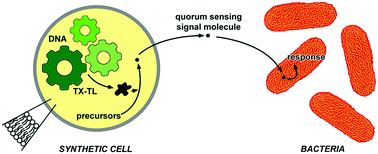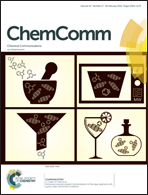Synthetic cells produce a quorum sensing chemical signal perceived by Pseudomonas aeruginosa†
Abstract
Recent developments in bottom-up synthetic biology (e.g., lipid vesicle technology integrated with cell-free protein expression systems) allow the generation of semi-synthetic minimal cells (in short, synthetic cells, SCs) endowed with some distinctive capacities of natural cells. In particular, such approaches provide technological tools and conceptual frameworks for the design and engineering of programmable SCs capable of communicating with natural cells by exchanging chemical signals. Here we describe the generation of giant vesicle-based SCs which, via gene expression, synthesize in their aqueous lumen an enzyme that in turn produces a chemical signal. The latter is a small molecule, which is passively released in the medium and then perceived by the bacterium Pseudomonas aeruginosa, demonstrating that SCs and bacteria can communicate chemically. The results pave the way to a novel basic and applied research area where synthetic cells can communicate with natural cells, for example for exploring minimal cognition, developing chemical information technologies, and producing smart and programmable drug-producing/drug-delivery systems.



 Please wait while we load your content...
Please wait while we load your content...